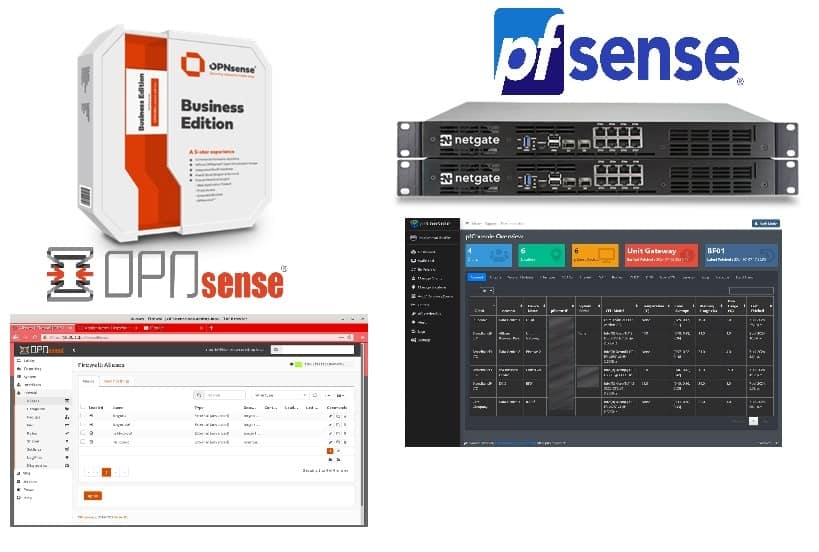PfSense vs OPNsense: Which Open-Source Firewall is Right for You?
Choosing the right firewall is crucial for network security, performance, and ease of management. Two leading open-source firewall solutions, pfSense and OPNsense, dominate the market—but which one is best for your needs?
This article compares pfSense vs. OPNsense in terms of features, performance, security, and usability, followed by an FAQ to help you decide.
Key Differences between PfSense vs OPNsense at a Glance
| Feature | pfSense | OPNsense |
| Based On | FreeBSD | Hardened FreeBSD |
| UI | Classic (older design) | Modern, user-friendly |
| Updates | Regular, but slower major releases | Frequent, automated updates |
| Security | Strong, but fewer built-in tools | More security-focused (e.g., LibreSSL, Zenarmor) |
| Plugins | Large community repository | Smaller but growing selection |
| VPN Support | OpenVPN, IPsec, WireGuard (via plugin) | OpenVPN, IPsec, WireGuard (built-in) |
| High Availability | Yes (CARP) | Yes (with improvements) |
| Commercial Backing | Netgate (paid support available) | Deciso (paid appliances & support) |
Detailed Comparison PfSense vs OPNsense
- User Interface & Usability
- pfSense: Uses a traditional, functional UI that may feel outdated but is highly configurable.
- OPNsense: Offers a modern, intuitive dashboard with better visualization (graphs, traffic monitoring).
Winner: OPNsense (better for beginners and admins who prefer a clean UI).
- Security Features
- pfSense: Relies on OpenSSL, strong firewall rules, and Suricata/Snort for IDS/IPS.
- OPNsense: Uses LibreSSL (security-focused fork), includes Zenarmor (next-gen firewall), and supports Unbound DNS over TLS by default.
Winner: OPNsense (more proactive security enhancements).
- Performance & Hardware Support
- Both run efficiently on x86 hardware (PCs, appliances, VMs).
- pfSense has broader ARM support (e.g., Netgate appliances).
- OPNsense has better real-time traffic shaping.
How to block Website in Mikrotik Router OS from Winbox [URL & Keywords]
Winner: Tie (depends on hardware).
- VPN & Networking
- pfSense: Strong IPsec & OpenVPN, but WireGuard requires a plugin.
- OPNsense: Built-in WireGuard, easier VPN configuration.
Winner: OPNsense (better VPN flexibility).
- Updates & Stability
- pfSense: Updates may be slower, but CE (Community Edition) is stable.
- OPNsense: Frequent updates, automated security patches.
Winner: OPNsense (better for staying up-to-date).
FAQ: pfSense vs OPNsense
- Which is better for home use?
- OPNsense is more user-friendly with a modern UI.
- pfSense is great if you need ARM support (e.g., Raspberry Pi).
- Which is more secure?
- OPNsense uses LibreSSL and has Zenarmor for advanced threat protection.
- pfSense is still secure but requires more manual hardening.
- Does OPNsense support WireGuard?
Yes, WireGuard is built-in (no plugin needed).
- Can I migrate from pfSense to OPNsense?
Yes, but you’ll need to backup configs and manually reconfigure some settings.
- Which has better community support?
- pfSense has a larger community (forums, Reddit).
- OPNsense has better official documentation.
- Which is better for enterprise use?
- pfSense (with Netgate support) is common in enterprises.
- OPNsense is gaining traction with better automation.
- Is OPNsense a fork of pfSense?
Yes, OPNsense was forked from pfSense in 2015 but has evolved independently.
Final Verdict: Which Should You Choose?
Choose pfSense if you:
Need ARM support (e.g., Netgate devices).
Prefer a proven, stable firewall with a large community.
Use complex networking setups (e.g., multi-WAN).
Choose OPNsense if you:
Want a modern UI & easier management.
Need built-in WireGuard & Zenarmor.
Prefer frequent security updates.
Conclusion
Both pfSense and OPNsense are excellent open-source firewalls. If you prioritize user-friendliness and security, go with OPNsense. If you need stability and broad hardware support, pfSense is a solid choice.
Related Post
- How to Change Comcast Xfinity Router WiFi password
- How To Make Google Docs Dark Mode in iPhone, Android and PC
- Best WiFi Routers for Gaming in Tri-Band [5GHz+5GHz+2.4GHz]


